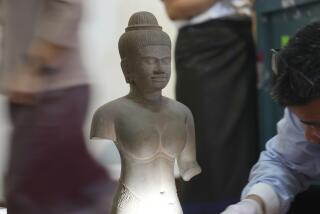Recovered Iraqi art treasures will be shown in Baghdad
- Share via
BAGHDAD — In what promises to be one of the few hopeful signs in a city still precariously balanced at the edge of chaos, the Iraq Museum plans to hold a one-day exhibition Thursday -- its first since the outbreak of war more than three months ago.
The show is designed to ease the minds of those who worried that the museum’s collections had been devastated by a frenzied, two-day looting spree in mid-April while American troops were fighting to secure the city.
At the time, museum officials claimed that the majority of its holdings -- which date back thousands of years and include the world’s foremost collection of Mesopotamian antiquities -- had been destroyed or stolen.
That announcement caused an international uproar, and U.S. officials bore much of the blame for failing to secure the museum. Since then, however, the accounting of the losses has been severely revised.
Investigators now say that fewer than 3,000 items are unaccounted for. Of these, only a handful are considered major pieces. Many of the missing objects were discovered in museum vaults that have only recently been opened.
The Treasure of Nimrud -- a remarkable assortment of gold plates, jewelry and musical instruments that dates to 900 B.C. -- was found across town in a vault at the Iraqi Central Bank. Still other works were returned in the weeks after the looting.
Among the highlights of Thursday’s exhibition will be the 5,000-year-old Vase of Warka, a sacred stone ritual vessel considered the oldest of its kind in the world, as well as an ancient bronze bas-relief bull and a fragment of a column decorated with mother of pearl.
Also on display will be objects smashed by looters, such as a 9th century B.C. statue of King Shalmanezzer III and a lion sculpture that dates to Babylonian times.
According to museum director Donny George, all these items were returned by good Samaritans who had sought to protect them from thieves during the chaotic days of looting.
Sitting under the covered porch that marks the museum’s main entrance, with a cluster of U.S. military vehicles parked nearby, George said two Iraqis, probably in their mid-30s, pulled up to the museum’s front gate on June 12, asking for the museum director. They opened the trunk of their car to reveal the stolen vase, which had sustained significant damage. The men claimed they had removed it during the looting and had kept it safely at home until they felt the museum was once again secure.
In a separate interview, the museum’s deputy director, Ahmed Kamil, said the men were offered a reward but refused to accept it. Kamil said the bull and the fragment of column were returned later by three other men under similar circumstances.
George sees no reason to doubt the men’s stories; on the contrary, he sees them as evidence of Iraqi patriotism. “They are heroes,” he said, “and I hope we can find some kind of reward for them.”
As a gesture of thanks, George has invited them to the opening, where they will be presented to the media as “excellent examples of Iraqis who did their duty.”
Others, however, are more suspicious of George’s motives. They see such staged events as an effort to put a positive spin on the initial exaggerations and subsequent controversy over the museum’s loses.
An Italian official involved in the international investigation of the stolen items, who spoke on condition of anonymity, suggested that a far more likely scenario is that the thieves did not realize how difficult it would be to smuggle the objects out of the country.
“I think they were probably afraid of getting caught,” he said. “None of the objects looted from the archeological sites, for example, have been returned. This is because there is no record of them. The museum pieces are well-known. They would be much harder to sell unnoticed.”
Even George acknowledges that the motives of some of those who turned in stolen objects may have been more complex.
In the days after the looting, he says, some U.S. soldiers gave money to Iraqis for the return of various coins and seals taken from the museum’s vaults. That may have encouraged others to return stolen artifacts, he says. (A U.S. military official in Baghdad denies that any rewards were offered.)
In the end, what may matter most is that the scope of the museum’s losses is far less than originally thought, and that the country’s artistic legacy, although cracked, remains largely intact.
“These days, we are not really interested in who looted the museum,” said Kamil, “but in how to get [the objects] back.”
More to Read
The biggest entertainment stories
Get our big stories about Hollywood, film, television, music, arts, culture and more right in your inbox as soon as they publish.
You may occasionally receive promotional content from the Los Angeles Times.










